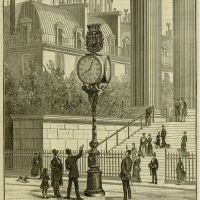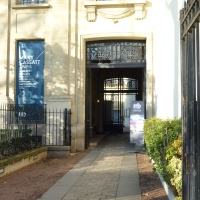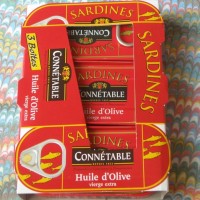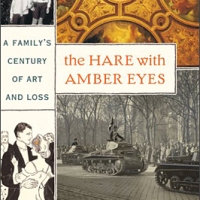There are not a lot of private houses in Paris. Let alone private houses with a direct view of the river and the Eiffel Tower. So 34, avenue New York, home of the Mona Bismarck American Center for Art and Culture, is already something out of the ordinary.
We went there last December to see an exhibit of prints and drawings by Mary Cassatt (I wrote an article about it for Girls’ Guide to Paris). The exhibition was interesting, but I was captivated by the house. The lunchroom offered a view of an enclosed garden, and a large poster on the wall provided the beginnings of an answer to the question in my mind: “Mona Who?”
The short answer would be: a fabulously wealthy American society hostess (1897–1983), once nominated the “Best-Dressed Woman in the World,” and benefactress of the institution that occupies her former Paris residence.
There was a second exhibit on the upper floor, and I climbed the oval staircase to look around. A large room contained a grand piano, a gilded mirror, some candle sconces, and a few pictures. I spotted a small corridor leading to a powder room.
One seldom has the opportunity to wash one’s hands and comb one’s hair in such elegant surroundings, and for a few minutes, I made myself at home.
There were three black and white portraits of Mona on a ledge, so I photographed them (badly). However, I later found clearer versions of the same images online. Here is one of them.
Back home in Toronto, I decided to find out more about the woman whose house I had visited. There is remarkably little written about Mona Bismarck. And after reading what there was, I think I know why. Here is the story.
Mona (or Frances) Strader was the daughter of a Kentucky horse breeder and trainer, Robert Strader. Her childhood was sad and chaotic. Her parents divorced when she was four or five years old. She lived first with her maternal grandmother, then with her paternal grandmother. The former was later declared insane and sent to an asylum. An uncle suffered the same fate. Another uncle shot a prostitute and then turned the gun on himself. A third uncle died in a hunting accident. Only her father seemed to be a steady influence in Mona’s life, and he was not always around.
The only way out of this nightmare was marriage. Mona’s starter husband was Henry James Schlesinger, son of the richest man in Wisconsin. She’d met him through her father’s racing contacts. She was 19; he was 39. The marriage was not a success. In 1920, Mona sought a divorce after three years of marriage, and left her young (and only) son in her husband’s custody in Milwaukee.
At this point, she had already met husband No. 2, a wealthy banker called James Irving Bush, said to be the “handsomest man in America.” The two married in New York in 1921; she was 24; he was 38. Fairly soon, Mona discovered that her new husband behaved appallingly when he was drunk, and he was often drunk. This time she went to Paris to obtain a divorce (note to self: find out more about Paris as the “divorce destination” in the 1920s and 1930s).
Back in New York, Mona started up a fashion venture with a friend called Laura Curtis, who was engaged to be married to Harrison Williams, one of the richest men in the United States (a big step up from the richest family in Wisconsin). Rumours abounded that Mona “stole” Harrison’s affections while her friend was out of town. In fact, Laura Curtis jilted Harrison Williams, leaving him free to marry Mona. But the rumours won and it took Mona some time to live them down.
Fortunately, she didn’t have to do so while living in New York. Harrison Williams took her on a honeymoon cruise around the world in his enormous yacht, Warrior. She was 29; he was 53. It was 1926.
Three years later, the stock market crash reduced her husband’s fortune of $680 million to a paltry $5 million. The Harrison Williamses apparently failed to notice their change in fortunes. They had a Long Island mansion at Oak Point; a New York town house on Fifth Avenue; an all-white house decorated by Syrie Maugham in Palm Beach; a Paris apartment on the rue Pouquet; and a villa with a large garden on the Island of Capri in the Bay of Naples called Il Fortino.
Meanwhile, Mona had become the darling of the fashion mavens. Cecil Beaton never tired of photographing or drawing her, although he said he could never fully capture the beauty of her huge acquamarine eyes and extraordinary silver hair.
Vogue and Harper’s Bazaar published endless stories about her exquisite life and clothes. And in 1933, the Paris couturiers Molyneux, Lanvin, Vionnet, Chanel and Lelong voted her the world’s “best-dressed woman.” Okay, the nomination was a little self-serving, since she wore their creations, but they were not alone in praising her sense of style. And in the end, it was Balenciaga who was her favourite couturier; he opened his fashion house in Paris in the late 1930s.
Perhaps the best way to sum up Mona’s life at this point was the phrase used in 2007 by Emily M. Banis in the title of her master’s thesis for the Fashion Institute of Technology in New York: “Mona: Portrait of a Female Dandy.”
Mona was a “dandy” in the sense that her greatest creation, her work of art, was her own appearance and her lifestyle. That was what she did. That was all she did. Nobody ever saw her reading a book. Nobody ever credited her with a witty remark. If she wrote letters, they were unquotable. She never learned French or Italian, despite years spent in those countries.
What Mona created was herself. After her chaotic and unhappy childhood, her achievement was to control every aspect of her life. Her houses were perfect. Her clothes were perfect. Her dinners were perfect. Her flowers were perfect (she loved gardening and grew her favourite flowers from Kentucky and England in the gardens in Capri, even though every drop of fresh water had to be brought from the mainland). Nothing less than perfection was acceptable.
In 1943, Dali painted her in an extraordinary portrait. In the first version, he painted her naked, but she objected, so he painted her wearing rags (but with her ever-present pearls), surrounding by objects from antiquity that evoke a certain menace. Apparently Mona loved it and it graced her Paris house on the avenue New York until a few weeks ago.
Harrison Williams died in 1953. His obituary in the New York Times noted: “The only reason the Harrison Williamses don’t live like princes…is that princes can’t afford to live like the Harrison Williamses.”
The following year, Mona acquired the final feature her life had lacked: an aristocratic title. She married Count Edward von Bismarck, the grandson of the German chancellor of that name. Eddie was thought to be gay, but he had been Mona’s long-time friend and confidant. He apparently believed that he was dying of stomach cancer, and she may have married him assuming it would be a very short marriage and a long widowhood. Eddie lived for another 16 years.
By this time, Mona had lost her trademark silver hair. In the 1950s, according to most sources, she started to dye her hair brown, and her friends were astonished that she would give up her most recognizable feature. Maybe, in middle age, she no longer wanted to be so recognizable.
Mona was devastated by the closing of the house of Balenciaga in 1968. The story goes that when she heard the news, she did not leave her room for three days. After this period of mourning, she switched to Givenchy.
Eddie died in 1970. Mona then married his doctor, Umberto de Martini, 14 years her junior. Big mistake. She thought he would look after her as she aged, as he had looked after Eddie; he thought she would fund his extracurricular activities, which included a mistress in England. When in 1979, he accidentally drove his Alfa Romeo off a bridge near Naples (her friends made the inevitable joke about “Martini on the rocks”), she was delivered from a burdensome marriage. She went back to using Bismarck as her surname.
She lived for four more years, dying in 1983 at her house on the avenue New York, aged 86. The terms of her will would have created an arts foundation that encompassed her Paris house and the artworks in her villa at Capri. But she had forgotten her son by her first marriage, who contested the will and demanded an inheritance larger than the measly million or so she had assigned him. The Capri villa and its contents had to be sold, along with other parts of her collection.
Mona created herself. And when she died, her greatest achievement in life disappeared. Beauty and a glamorous lifestyle do not survive when the individual who brings them to life has gone. And exotic gardens may not survive the death of a gardener. This, I think, is why so few people have written about her, and why there is no full-length biography.
I didn’t know any of this as I washed my hands and snapped a couple of pictures of Mona’s first-floor powder room. She was a remote presence, a name on an oil painting in the front hall. But clearly many people have benefited from her legacy. The Mona Bismarck American Center may not be as well funded as Mona wanted it to be, but it nonetheless sponsors concerts and exhibitions that Paris residents and visitors enjoy, and the exhibit I saw was beautifully presented. The Center’s recent sale of the Dali portrait will contribute to its work. On February 5, 2013, the painting fetched a price of 2.6 million Euros at Sotheby’s in London.
Poor Mona. She had beauty, wealth, and an exalted social position. But in the photographs and portraits, she does not look happy. Be careful what you wish for. She wished for riches and control; she had riches during her life, but she could not quite control her legacy.
Text and original photographs by Philippa Campsie
Sources: Emily M. Banis, Mona: Portrait of a Dandy, New York: Fashion Institute of Technology, master’s thesis, 2007; James D. Birchfield, Kentucky Countess: Mona Bismarck in Art and Fashion, Lexington: University of Kentucky Art Museum, 1997; Annette Tapert and Diana Edkins, The Power of Style, New York: Crown Publishers, 1994.
































Wonderful article. Mona traveled with two identical Rolls. One for her and the Count and one for the luggage and the maid/valet. I saw her once arrive at the Hotel du Cap for a luncheon stop on her way south. She always wore a hat and gloves. The news once had an article where the luggage car caught fire and burned her wardrobe. This did not stop her from being late for a luncheon appt.
Tell me more. You saw her?
I really enjoyed reading this article. During my wanderings in Paris I often fantasize how it must have been to have lived in some of the places I have visited. This would have been one of them.
However I don’t envy her life.
I don’t either. Reading about her life, I immediately felt better about being unfashionable, imperfect, servant-less. Her life was very sad in many ways.
I can’t remember exactly what she had on except it was a suit with wide white collar and dark gloves. She used to frequent New Jimmy’s in Paris, a famous nightclub where everyone went. She was a friend of Millicent Rogers, CZ Guest, Peggy Bancroft and all that crowd. There are still ladies here in Palm Beach who remember her. my mother had a house in Cannes and you used to see everyone at the Carlton. The casino at Monte Carlo was full of famous faces. I was about 16 or so when my mother took me there. I met ex king Farouk who was a real joy to be around. He used to come to dinner at the Carlton but that is another story. I remember eating hamburger at the Crazy Horse when it was in its “Western” mode. Paris was very different in the late 50s and 60s when I was a kid.Of course, no one is left. Everyone stays home or goes to the Hamptons or where ever. Some of the older men like Alain Delon anf Taki are still around.
I LOVED reading this post. Even though you mentioned there are no witty comments attributed to her, I bet with that roller coaster of a life she must have said a thing or two that would make us all laugh (or roll our eyes) today. I have to say I’m always fascinated by a woman who can get 5 men to marry her!
The books did say that she was a very good listener. That is a valuable quality that many men appreciate.
Lynn. back then Everyone got married a lot or at least went out with stunning men. Aly Khan and Rubirosa were not they only ones. Everyone married for money or a title no matter how obscure or even younger like Rosemarie Kanzler. The beautiful Dagmar de Brantes left her philandering husband (who liked the kitchen maid) had no trouble amongst the billionaires of the day courting her. Peggy Bancroft kept marrying up each title (she paid of course and made lots of antique dealers rich) Angelli had his yacht and all the beautiful people while wife stayed home in italy. Everyone you knew was at il Pelicano, Eden Roc or Capri. And smartly dressed. Nowdays Cannes is full of Russian Hookers and people who should go in thru the service door. There is no glamour on a daily basis any longer..Dressing for one night on the red carpet does not do it. Joan Rivers is the best dressed woman today in the old style. The new “Best-dressed” list by Vanity Fair mag. is a laugh. Except for Oscar, Carolina, Ralph,McQueen designers hate women and if you look at the most recent shows Mona von Bismark wouldn’t be caught wearing most….
Cannes line is hilarious. Chapeau!
My morning chuckle: Martini on the rocks!
Thanks again Philippa!
Pingback: The Paris Blog: Paris, France Expat Tips & Resources »Blog Archive » A Fashionista, Forgotten
Wonderful how your inquisitiveness in a powder room led to such a fascinating story.
A very good take on a fascinating and complex woman ~ had she lived in the current era, she would have undoubtedly been a Martha Stewart figure or someone comparable.
As it happens, I grew up next door to “Mrs. Bismarck” in Bayville, NY, and I remember her vividly enough to have written a novel about her called “Oak Point,” which is currently making the rounds. Happy to email a copy to anyone who is interested. Also have a Facebook page (monathebook) and all the other social media sites. Click my name for the Pinterest page, filled with more photos from my private collection and comments about the woman and her vanished era.
My babysitter’s father was superintendent of her amazing exotic bird collection, and she often took me over there when I was three or four years old. Most of those birds were bigger than me! Caramba! With a skeleton staff of about fifty, many of the villagers worked for her, and no one who ever met her forgot her.
My father, a lawyer, and my mother, president of the village planning board, sued her three times to tone down the development of her estate when she came to dispose of it in the late sixties. As an “abandoned” estate of about 50 acres (she gave the rest to the village for a tax write-off) Oak Point made an ideal setting for various illicit teen activities, many of which are chronicled in my book.
“Oak Point” is also the first novel with Cristobal Balenciaga as a central character, and his mentor/muse relationship to Mona is essayed in some depth. My fashion editor (and dear friend from prep school days) did his estage at the house of Givenchy, giving, one hopes, the details of the world of haute couture some verisimilitude.
OK, I’m done.
How I wish I’d known about your book when I wrote the blog. I certainly want to read it. She is quite fascinating, and it is interesting to see that she wasn’t quite as “forgotten” as I thought. Thank you so much for getting in touch. I have looked at the Facebook page and I am impressed by all the images you have of her and her surroundings.
Philippa
Are you still willing to send an email copy of your book? I am researching Mrs. von Bismarck as she was the inspiration for Truman Capote’s Kate McCloud from Answered Prayers. Thank you!
happy to – let me know a good address to send it to. ~ed
https://circusinthewishingwell.wordpress.com/
Are you sending it via email attachment?
as you wish~
Yes, thank you. This is much appreciated!
The email is as posted here.
KM
hope this gets to you!
best,
ed
________________________________
i lost everything – every file and jpeg – while getting my computer fixed – have to reconstruct a little. i will send a PDF attachment. your email is on the blog? i’ll look! ~ed
I grew up in Mona’s chauffeur’s house, on Oak Place and Mountain Avenue. I’ve always been fascinated by her.
Thank you for this blog, and the photos from the Paris home of the late Mona Williams (von Bismarck). I enjoyed reading it, and the comments as well. I am presently working on a historical piece that started as an examination of some unsolved missing persons cases in South Florida, but expanded into much more as i encountered some colorful characters along the way in the research. The work has taken on a life of its own and now encompasses a great deal of human history, as well as a close-up of life in South Florida from the perspective of a wallflower (me). My only mention of Mona is really her time in Palm Beach, but I want to footnote in the work where people can read more about some of the fascinating people introduced, and Mona is certainly one of them! So it is very nice to learn of Ed’s work, that can be used as a referral for more in-depth reading of this very interesting woman. I will say that her friends and acquaintances here did all seem to mention that she was an incredibly gracious hostess. She and Mr. Harrison Williams, her husband in the time period I am writing about, had a revolving door of extended-stay guests. Her menu planning was thoughtful and dinner parties flawless. She made sure the guest rooms were anointed with the favorite blooms of her company. And for someone who was not a fashion model, photographers certainly loved to capture her! Thanks again to you and all who commented here – the insight is tremendous.
We are delighted that you enjoyed the post and took the time to tell us about your own work. It sounds very interesting, and when it is published, please let us know.